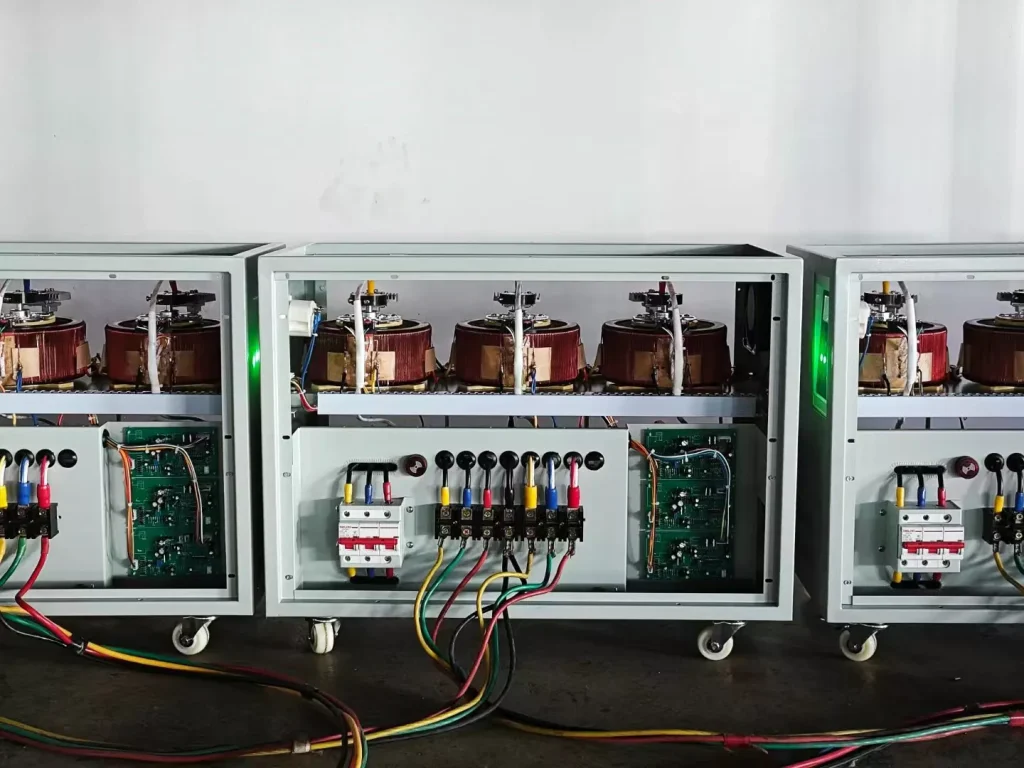1, UPS power supply system on, off
- (1) Close the gate in the following order: energy storage battery switch → automatic bypass switch → output switch is placed in “ON”.
- (2) Press the “ON” key of UPS startup panel, the UPS power supply system will start slowly, the “inverter” indicator light will be on, after a delay of 1 minute, the “bypass” light will be off, and the UPS will turn to inverter power supply, completing the startup. After a delay of 1 minute, the “bypass” light will go out and the UPS will turn to inverter power supply to complete the power on.
After about 10 minutes of no-load operation, the load will be started according to the order of load power from small to large.
Power on: just press the UPS panel “on” button, about 20 minutes, you can turn on the computer or other instruments to use. Usually wait until the UPS starts to enter the stable work, before you open the load equipment power switch (Note: manual maintenance switch in the normal operation of the UPS, is “OFF” state).
Shutdown: the first computer or other instruments off, let the UPS run unloaded for 10 minutes, to be discharged after the heat inside the machine, and then press the panel “off” button.
2, UPS power system precautions
UPS power supply system because of its high degree of intelligence, energy storage batteries using maintenance-free batteries, which brings a lot of convenience to the use, but in the use of the process should also pay attention to a variety of aspects, in order to ensure the safety of use.
- (1) UPS power supply host does not require high ambient temperature, +5 ° C to 40 ° C can work normally, but requires indoor clean, less dust, or dust plus humidity will cause the host to work in disorder. Storage batteries, on the other hand, have higher temperature requirements, the standard operating temperature of 25 ℃, usually can not exceed +15 ℃ ~ +30 ℃. Temperature is too low, will make the storage battery capacity decline, the temperature drops 1 ℃, its capacity decreased by 1%. Its discharge capacity will increase with the temperature, but the life expectancy is reduced. If it is used for a long time under high temperature, the battery life will be reduced by about half for every 10℃ higher temperature.
- (2) The parameters set in the host computer cannot be changed at will during use. In particular, the parameters of the battery pack will directly affect its service life, but with the change of ambient temperature, the float voltage should be adjusted accordingly. Usually take 25℃ as the standard, when the ambient temperature increases or decreases by 1℃, the float charging voltage should be increased by 18mV (relative to 12V battery).
- (3) in the absence of external power supply by the UPS power supply system on its own, should avoid starting the UPS power supply with a load, should first shut down the load, such as the UPS power supply system to start and then turn on the load. Because the load instantaneous power supply will have an impact battery, the impact current of multiple loads and plus the required power supply current will cause instantaneous overload of the UPS power supply, serious damage to the converter.
- (4) UPS power supply system according to the use of the required power margin is not large, in use to avoid arbitrarily increase the high power of additional equipment, but also does not allow long-term operation under full load. However, the nature of the work determines the UPS power system is almost uninterrupted operation, increase high-power loads, even in the basic full-loaded state of work, will cause the host to malfunction, and in severe cases will damage the converter.
- (5) The output voltage of the self-provided generator, waveform, frequency, amplitude should be full of UPS power supply on the input voltage requirements, the other long generator power to be much greater than the rated power of the UPS power supply, otherwise any condition is not satisfied, will cause the UPS power supply work abnormally or damaged.
- (6) due to the combined battery pack voltage is very high, there is a risk of electric shock, so loading and unloading of conductive connectors, output lines should be safe, tools should be insulated, especially the output contacts should be anti-touch measures.
- (7) Whether in the float charging state or in the charging, discharging maintenance test state, to ensure that the voltage and current meet the specified requirements. Excessive voltage or current may cause thermal runaway or water loss of the battery, voltage, current is too small will cause battery loss, which will affect the service life of the battery, the former has a greater impact.
- (8) In any case, the battery should be prevented from being short-circuited or deeply discharged, because the cycle life of the battery is related to the depth of discharge. The deeper the discharge depth, the shorter the cycle life. In the capacity test or discharge maintenance, usually discharged to 30% to 50% of the capacity is enough.
- (9) The battery should avoid high-current charging and discharging, although in charging can accept high current, but in practice should be avoided, otherwise it will cause the battery plate expansion and deformation, making the plate active material off, the battery internal resistance increases, the higher the temperature rise, and in serious cases, will cause a decline in capacity, the life of the battery is terminated prematurely.


